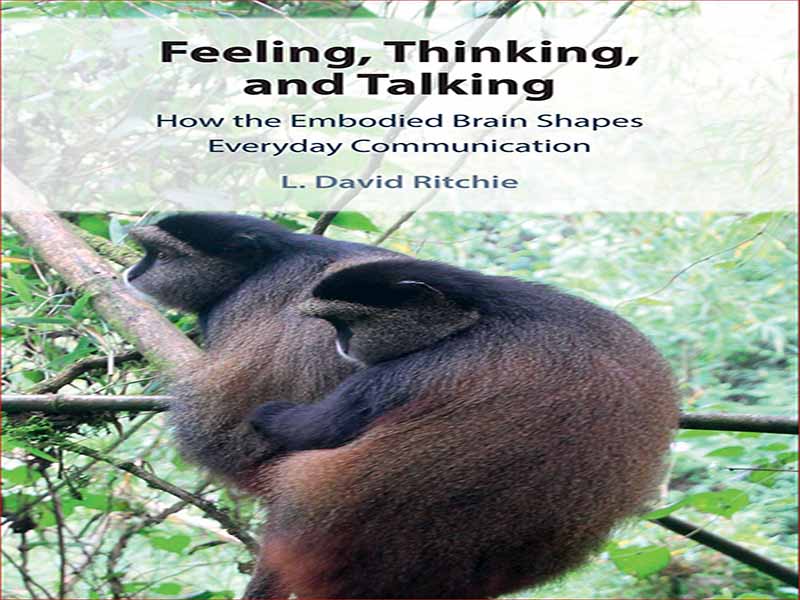- عنوان کتاب: Feeling, Thinking, and Talking
- نویسنده: l. david ritchie
- حوزه: زبان شناسی
- سال انتشار: 2022
- تعداد صفحه: 366
- زبان اصلی: انگلیسی
- نوع فایل: pdf
- حجم فایل: 7.28 مگابایت
من در سال 1983 با علاقه به ذهن/مغز انسان و نحوه تعامل آن با انسان های دیگر برای ساختن و کشف معنا وارد مقطع کارشناسی ارشد شدم. همانطور که تئوری ها و روش های رویکرد تجربی/رفتاری به ارتباطات را که در استنفورد تدریس می شد یاد گرفتم، بارها از نادیده گرفتن فرآیندهای شناختی که از طریق آن پیام ها ایجاد و درک می شوند، ناامید شدم، غفلتی که در آن زمان در همه علوم اجتماعی رایج بود. در آن زمان، مغز هنوز یک “جعبه سیاه” غیرقابل نفوذ در نظر گرفته می شد: انجام صحیح تحقیق مطالعه رابطه “ورودی ها” با “خروجی ها” بود، بدون حدس و گمان بیهوده در مورد آنچه ممکن است بین آنها اتفاق بیفتد. در آن زمان، در اوایل دهه 1980، محاسبات، و به ویژه هوش مصنوعی (AI)، در حال ورود به روزهای شکوه خود بود. من این شانس را داشتم که اکنون بدون گذراندن یک دوره واحد در این زمینه وارد رشته ارتباطات شوم. این به من این امکان را داد که به موضوع بدون مفروضات و حقایق بدیهی نزدیک شوم، تحقیق را بخوانم و داده ها را با شرایط خاص خود بررسی کنم. من به ویژه مجذوب نظریه هایی بودم که ذهن و تعامل آن با معنا را بررسی می کنند. من قبلاً ابتدا مشتاق شده بودم، سپس از فروید ناامید شده بودم، سپس از یونگ. یکی یکی شیفته آن شدم، پذیرفتم، سپس از تئوری اطلاعات، هوش مصنوعی، 2 و نمونه های دیگر از آنچه به عنوان «استعاره رایانه» فکر می کنم ناامید شدم. مانند بسیاری دیگر از دانشجویان و دانش پژوهان آن دوره، من عمیقاً تحت تأثیر شرح نظریه اطلاعات شانون و ویور (1949) قرار گرفتم، اما توصیه ویلبر شرام مبنی بر «ابتدا خواندن ویور» را نادیده گرفتم. هنگامی که سرانجام ویور را خواندم، تضاد بین حدس و گمان های او و ریاضیات ظریف شانون باعث سرخوردگی من شد (و اولین انتشار آکادمیک من، که بعدها به اولین کتاب من منجر شد). من چندین مورد از جمله نسخه های مختلف نظریه همگرایی و “فضاهای ذهنی” را بررسی کردم. من متوجه شدم که همه این رویکردها این واقعیت را نادیده می گیرند که پیام ها هم توسط مغزهای زیستی تکامل یافته منشأ می شوند و هم درک می شوند، اگرچه سال ها مطالعه و مطالعه بیشتر طول کشید تا بفهمیم یک مغز بیولوژیکی تا چه حد در یک بدن بیولوژیکی جاسازی شده است، چگونه یک مغز بیولوژیکی متفاوت از یک کامپیوتر است، و چقدر این تفاوت مهم است. تقریباً در همان زمان، با ایده شبیهسازی ادراکی در تحقیقات شپرد 5 در مورد چرخش ذهنی مواجه شدم و شروع کردم به خواندن تمام مطالبی که در مورد این موضوع و موضوعات مرتبط پیدا میکردم. من همچنین با نظریه استعاره های مفهومی لاکوف و جانسون 6 مواجه شدم، اگرچه بیش از یک دهه طول کشید تا بتوانم به طور کامل متوجه شوم که با آن چه می توان کرد. در طول راه، من همچنین عمیقاً نسبت به توضیحات یک متغیره برای تجربه و رفتار انسان، بویژه ارتباطات، بدبین شدم. رقابت، قدرت، تمایلات جنسی همگی نقش دارند، همکاری، کنجکاوی، بازی، همدلی و تخیل – در میان بسیاری از عوامل دیگر. پایان نامه من، با استفاده از یک مدل همگرایی انتزاعی برای قدرت اجتماعی، من را متقاعد کرد که زمینه اجتماعی و فرهنگی مرکزی است، نه تصادفی. کار با مربیان – به ویژه استیو شافی، دان رابرتز، و مری آن فیتزپاتریک – من را متقاعد کرد که تعامل اجتماعی یک مؤلفه مهم است که هم منشأ و هم تفسیر سیگنالها را شکل میدهد، مؤلفهای که هیچ یک از مدلهای خطی که من آنقدر جذاب پیدا کرده بودم، نمیتوانست با موفقیت ترکیب کند. . زمانی که ری گیبز من را با لین کامرون و تجزیه و تحلیل گفتمان پویا آشنا کرد، قطعات شروع به قرار گرفتن در جای خود کردند. شواهد رابین دانبار7 مبنی بر اینکه زبان اساساً به روابط اجتماعی مربوط می شود تا اطلاعات بوم شناختی، کاتالیزور نهایی را ارائه کرد.
I entered graduate school in 1983 with an interest in the human mind/brain and how it interacts with other humans to construct and discover meaning. As I learned the theories and methods of the empirical/behavioral approach to communication taught at Stanford, I was repeatedly dismayed at the neglect of the cognitive processes through which messages are created and understood, a neglect that was then common to all the social sciences. At that time, the brain was still considered an impenetrable “black box”: The proper conduct of inquiry was to study the relationship of “inputs” to “outputs,”1 without futile speculation about what might happen between. At that time, in the early 1980s, computation, and particularly artificial intelligence (AI), was entering its glory days. I had what now seems like the good fortune to enter the communication discipline without having ever taken a single course in the subject. This has allowed me to approach the subject matter innocent of the taken-for-granted assumptions and verities, to read the research and examine the data on their own terms. I was especially fascinated by theories that examine mind and its interaction with meaning. I had already become first enthusiastic, then disappointed by Freud, then by Jung. One by one I became intrigued by, adopted, then became disappointed by information theory, AI,2 and other instantiations of what I have come to think of as “the computer metaphor.” Like many other students and scholars of the era, I was deeply impressed with Shannon and Weaver’s (1949) exposition of information theory, but I disregarded Wilbur Schramm’s advice to “read Weaver first.” When I finally did read Weaver, the contrast between his speculations and Shannon’s elegant mathematics led me to disillusionment (and my first academic publication,3 which later led to my first book4). I explored several including various versions of co-orientation theory and “mental spaces.” I came to realize that all these approaches disregard the fact that messages are both originated and understood by evolved biological brains, though it took many more years of reading and study to realize the extent to which a biological brain is embedded in a biological body, how different a biological brain is from a computer, and how important that difference is. At about that same time, I encountered the idea of perceptual simulation in Shepard’s5 research on mental rotation and began to read all I could find on this and related topics. I also encountered Lakoff and Johnson’s6 theory of conceptual metaphors, though it would be over a decade before I was able to realize fully what could be done with it. Along the way, I also became deeply skeptical of one-variable explanations for human experience and behavior, communication in particular. Competition, power, sexuality all play a role, as do cooperation, curiosity, play, empathy, and imagination – among many other factors. My dissertation, applying an abstract co-orientation model to social power, convinced me that the social and cultural context is central, not incidental. Working with mentors – especially Steve Chaffee, Don Roberts, and Mary Anne Fitzpatrick – convinced me that social interaction is a crucial component shaping both the origination and the interpretation of signals, a component none of the linear models I had found so intriguing could successfully incorporate. When Ray Gibbs introduced me to Lynne Cameron and Dynamic Discourse Analysis, the pieces began to fall into place. Robin Dunbar’s7 evidence that language is fundamentally about social relationships rather than ecological information provided the final catalyst.
این کتاب را میتوانید از لینک زیر بصورت رایگان دانلود کنید:
Download: Feeling, Thinking, and Talking



































نظرات کاربران